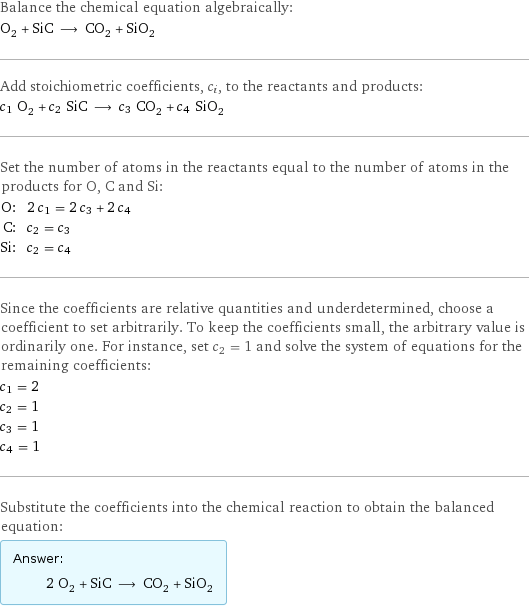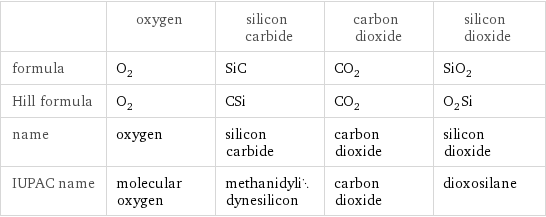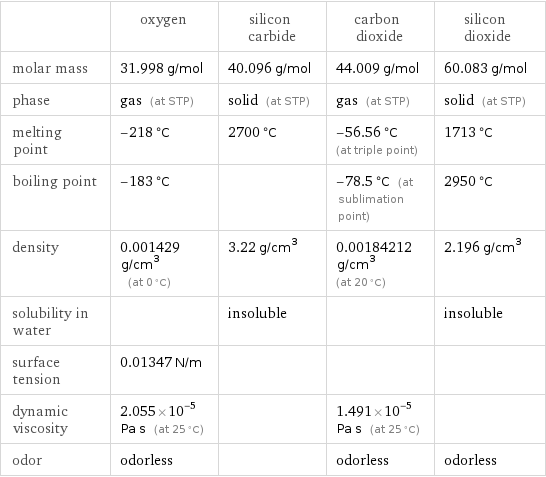Input interpretation

O_2 oxygen + SiC silicon carbide ⟶ CO_2 carbon dioxide + SiO_2 silicon dioxide
Balanced equation

Balance the chemical equation algebraically: O_2 + SiC ⟶ CO_2 + SiO_2 Add stoichiometric coefficients, c_i, to the reactants and products: c_1 O_2 + c_2 SiC ⟶ c_3 CO_2 + c_4 SiO_2 Set the number of atoms in the reactants equal to the number of atoms in the products for O, C and Si: O: | 2 c_1 = 2 c_3 + 2 c_4 C: | c_2 = c_3 Si: | c_2 = c_4 Since the coefficients are relative quantities and underdetermined, choose a coefficient to set arbitrarily. To keep the coefficients small, the arbitrary value is ordinarily one. For instance, set c_2 = 1 and solve the system of equations for the remaining coefficients: c_1 = 2 c_2 = 1 c_3 = 1 c_4 = 1 Substitute the coefficients into the chemical reaction to obtain the balanced equation: Answer: | | 2 O_2 + SiC ⟶ CO_2 + SiO_2
Structures

+ ⟶ +
Names

oxygen + silicon carbide ⟶ carbon dioxide + silicon dioxide
Equilibrium constant
![Construct the equilibrium constant, K, expression for: O_2 + SiC ⟶ CO_2 + SiO_2 Plan: • Balance the chemical equation. • Determine the stoichiometric numbers. • Assemble the activity expression for each chemical species. • Use the activity expressions to build the equilibrium constant expression. Write the balanced chemical equation: 2 O_2 + SiC ⟶ CO_2 + SiO_2 Assign stoichiometric numbers, ν_i, using the stoichiometric coefficients, c_i, from the balanced chemical equation in the following manner: ν_i = -c_i for reactants and ν_i = c_i for products: chemical species | c_i | ν_i O_2 | 2 | -2 SiC | 1 | -1 CO_2 | 1 | 1 SiO_2 | 1 | 1 Assemble the activity expressions accounting for the state of matter and ν_i: chemical species | c_i | ν_i | activity expression O_2 | 2 | -2 | ([O2])^(-2) SiC | 1 | -1 | ([SiC])^(-1) CO_2 | 1 | 1 | [CO2] SiO_2 | 1 | 1 | [SiO2] The equilibrium constant symbol in the concentration basis is: K_c Mulitply the activity expressions to arrive at the K_c expression: Answer: | | K_c = ([O2])^(-2) ([SiC])^(-1) [CO2] [SiO2] = ([CO2] [SiO2])/(([O2])^2 [SiC])](../image_source/670fe164d65855cf7566f881843634ef.png)
Construct the equilibrium constant, K, expression for: O_2 + SiC ⟶ CO_2 + SiO_2 Plan: • Balance the chemical equation. • Determine the stoichiometric numbers. • Assemble the activity expression for each chemical species. • Use the activity expressions to build the equilibrium constant expression. Write the balanced chemical equation: 2 O_2 + SiC ⟶ CO_2 + SiO_2 Assign stoichiometric numbers, ν_i, using the stoichiometric coefficients, c_i, from the balanced chemical equation in the following manner: ν_i = -c_i for reactants and ν_i = c_i for products: chemical species | c_i | ν_i O_2 | 2 | -2 SiC | 1 | -1 CO_2 | 1 | 1 SiO_2 | 1 | 1 Assemble the activity expressions accounting for the state of matter and ν_i: chemical species | c_i | ν_i | activity expression O_2 | 2 | -2 | ([O2])^(-2) SiC | 1 | -1 | ([SiC])^(-1) CO_2 | 1 | 1 | [CO2] SiO_2 | 1 | 1 | [SiO2] The equilibrium constant symbol in the concentration basis is: K_c Mulitply the activity expressions to arrive at the K_c expression: Answer: | | K_c = ([O2])^(-2) ([SiC])^(-1) [CO2] [SiO2] = ([CO2] [SiO2])/(([O2])^2 [SiC])
Rate of reaction
![Construct the rate of reaction expression for: O_2 + SiC ⟶ CO_2 + SiO_2 Plan: • Balance the chemical equation. • Determine the stoichiometric numbers. • Assemble the rate term for each chemical species. • Write the rate of reaction expression. Write the balanced chemical equation: 2 O_2 + SiC ⟶ CO_2 + SiO_2 Assign stoichiometric numbers, ν_i, using the stoichiometric coefficients, c_i, from the balanced chemical equation in the following manner: ν_i = -c_i for reactants and ν_i = c_i for products: chemical species | c_i | ν_i O_2 | 2 | -2 SiC | 1 | -1 CO_2 | 1 | 1 SiO_2 | 1 | 1 The rate term for each chemical species, B_i, is 1/ν_i(Δ[B_i])/(Δt) where [B_i] is the amount concentration and t is time: chemical species | c_i | ν_i | rate term O_2 | 2 | -2 | -1/2 (Δ[O2])/(Δt) SiC | 1 | -1 | -(Δ[SiC])/(Δt) CO_2 | 1 | 1 | (Δ[CO2])/(Δt) SiO_2 | 1 | 1 | (Δ[SiO2])/(Δt) (for infinitesimal rate of change, replace Δ with d) Set the rate terms equal to each other to arrive at the rate expression: Answer: | | rate = -1/2 (Δ[O2])/(Δt) = -(Δ[SiC])/(Δt) = (Δ[CO2])/(Δt) = (Δ[SiO2])/(Δt) (assuming constant volume and no accumulation of intermediates or side products)](../image_source/7b0534780629a39164b9e074b3912433.png)
Construct the rate of reaction expression for: O_2 + SiC ⟶ CO_2 + SiO_2 Plan: • Balance the chemical equation. • Determine the stoichiometric numbers. • Assemble the rate term for each chemical species. • Write the rate of reaction expression. Write the balanced chemical equation: 2 O_2 + SiC ⟶ CO_2 + SiO_2 Assign stoichiometric numbers, ν_i, using the stoichiometric coefficients, c_i, from the balanced chemical equation in the following manner: ν_i = -c_i for reactants and ν_i = c_i for products: chemical species | c_i | ν_i O_2 | 2 | -2 SiC | 1 | -1 CO_2 | 1 | 1 SiO_2 | 1 | 1 The rate term for each chemical species, B_i, is 1/ν_i(Δ[B_i])/(Δt) where [B_i] is the amount concentration and t is time: chemical species | c_i | ν_i | rate term O_2 | 2 | -2 | -1/2 (Δ[O2])/(Δt) SiC | 1 | -1 | -(Δ[SiC])/(Δt) CO_2 | 1 | 1 | (Δ[CO2])/(Δt) SiO_2 | 1 | 1 | (Δ[SiO2])/(Δt) (for infinitesimal rate of change, replace Δ with d) Set the rate terms equal to each other to arrive at the rate expression: Answer: | | rate = -1/2 (Δ[O2])/(Δt) = -(Δ[SiC])/(Δt) = (Δ[CO2])/(Δt) = (Δ[SiO2])/(Δt) (assuming constant volume and no accumulation of intermediates or side products)
Chemical names and formulas

| oxygen | silicon carbide | carbon dioxide | silicon dioxide formula | O_2 | SiC | CO_2 | SiO_2 Hill formula | O_2 | CSi | CO_2 | O_2Si name | oxygen | silicon carbide | carbon dioxide | silicon dioxide IUPAC name | molecular oxygen | methanidylidynesilicon | carbon dioxide | dioxosilane
Substance properties

| oxygen | silicon carbide | carbon dioxide | silicon dioxide molar mass | 31.998 g/mol | 40.096 g/mol | 44.009 g/mol | 60.083 g/mol phase | gas (at STP) | solid (at STP) | gas (at STP) | solid (at STP) melting point | -218 °C | 2700 °C | -56.56 °C (at triple point) | 1713 °C boiling point | -183 °C | | -78.5 °C (at sublimation point) | 2950 °C density | 0.001429 g/cm^3 (at 0 °C) | 3.22 g/cm^3 | 0.00184212 g/cm^3 (at 20 °C) | 2.196 g/cm^3 solubility in water | | insoluble | | insoluble surface tension | 0.01347 N/m | | | dynamic viscosity | 2.055×10^-5 Pa s (at 25 °C) | | 1.491×10^-5 Pa s (at 25 °C) | odor | odorless | | odorless | odorless
Units
